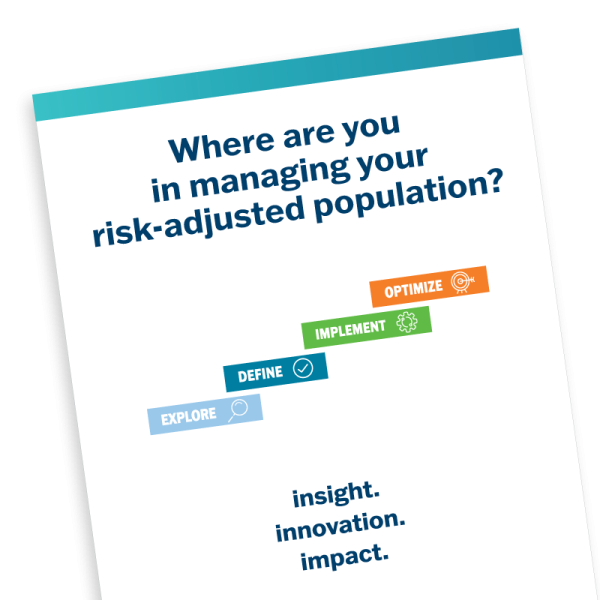As reimbursement models shift to value-based care, effectively managing the chronic conditions of your patient population is critical to revenue cycle performance.
The growth of the aging population and rising chronic disease is increasing the volume and need for value-based care (VBC).
Medicare Advantage, ACOs, and other shared savings programs are now tying reimbursements to hierarchical condition categories (HCC).
This means that it's more important than ever to make sure you are capturing the right HCCs to reflect an accurate risk adjustment factor (RAF) score for your patients.
Failing to adequately capture a patient's risk through medical documentation and coding may lead to an inaccurately low level of attributed risk and eventually to reduced reimbursement.
HCC Risk Adjustment Maturity Model
The maturity model provides an initial benchmark for how close to 'fully optimized' your organization is in regards to addressing your risk-adjusted population. It's a useful tool for leading discussions and providing management with a roadmap for your next steps, as well as for receiving proper reimbursement for the care you've provided.
Click + to learn more.
Average reimbursement potential is
10-13X
Our clients realize up to
60%

Get credit for the care you provide.
Many providers are struggling to define and develop the capabilities they need to manage a value-based care model. They’re finding that lack of tools and data analytics is slowing down their progress to create an effective risk-adjusted population management strategy.
We created the HCC Risk Adjustment 3-Minute Checkup to help determine where you are in the process and to provide actions to advance to the next phase.
Capturing accurate RAF scores for your patients is key to improving quality of care and proper reimbursement.
The Centers for Medicare & Medicaid Services (CMS) plans to move all Medicare providers and 50% of Medicaid and commercial contracts to VBC models by 2025. So take action now since 2025 is right around the corner. Having an accurate RAF score is vital to your system's sustainability.
Managing HCC’s requires a different approach, process and tools than what has been used in the past. So, adding to your existing process and tools is not a recipe for success. You need a way to look at patients holistically, not just the encounter.

UASI WEBINAR SERIES
Successful HCC Risk-Adjusted Programs:
Tactics to Manage Your Risk-Adjusted Population
Watch our webinar on how ChristianaCare established their successful HCC-Risk adjusted programs and the steps they’re taking to effectively optimize their program. ChristianaCare is currently in the ‘optimize’ phase of the Risk Adjustment Maturity Model. This webinar offers powerful insights and perspectives for organizations in all phases.
Featuring:
- Mary Stanfill, MBI, RHIA, CCS, CCS-P, FAHIMA, Vice President of Consulting Services at UASI.
- Colleen White, MSM, BSN, RN, CPC, Ambulatory CDI Program Manager at ChristianaCare. Colleen has been with ChristianaCare for 21 years and in the CDI program for 2.5 years.
Learn more about HCC Risk Adjustment solutions
Contact UASI if you’d like to speak with one of our HCC risk adjustment experts for guidance on your next steps.
About UASI
UASI is a leading national provider of revenue cycle solutions that help healthcare organizations receive proper reimbursement for the care they provide. With nearly 40 years of experience in coding, documentation, clinical documentation integrity (CDI), and revenue integrity solutions, UASI staff members are the industry’s most experienced and credentialed professionals. UASI offers full-service consulting to identify inaccuracies and strategic solutions to drive coding and documentation quality improvements. https://uasisolutions.com
© 2022, UASI, United Audit Systems, Inc. All rights reserved. | uasisolutions.com
